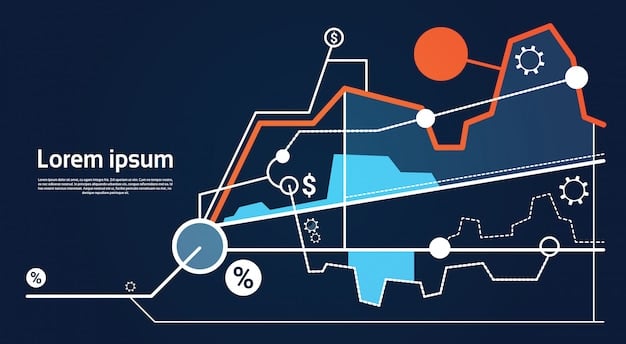Economic Forecasting 2025: Business Recession Prep Guide

Navigating the complex landscape of economic forecasting: preparing your business for potential recessionary pressures in 2025 is crucial for resilience and sustained growth, demanding proactive strategies aligned with data-driven insights to mitigate risks and capitalize on emerging opportunities.
As businesses look ahead, the economic horizon of 2025 presents a unique blend of potential growth and inherent uncertainties. Understanding these dynamics is paramount, especially when considering Economic Forecasting: Preparing Your Business for Potential Recessionary Pressures in 2025. This guide offers insights to help you navigate these potential challenges proactively.
Understanding the Current Economic Climate and Its Trajectory
The global economy operates within a delicate balance, continually influenced by a myriad of interconnected factors. As we approach 2025, a comprehensive understanding of the present economic climate is not merely academic; it is a foundational necessity for strategic business planning. Current indicators suggest a complex tapestry of inflationary pressures, supply chain adjustments, and evolving consumer behaviors, all of which contribute to an inherently uncertain but not unpredictable future.
Analyzing key macroeconomic indicators provides a clearer picture. Inflation, while showing signs of moderation in some sectors, remains a persistent concern, impacting everything from raw material costs to consumer purchasing power. Central banks worldwide continue to grapple with tightening monetary policies to curb inflation, a process that inherently carries the risk of dampening economic activity. The labor market, surprisingly resilient in many regions, faces its own set of challenges, including skills gaps and shifts in workforce demands.
Global Economic Drivers and Their Impact
Several global drivers are shaping the economic trajectory beyond 2024. Geopolitical tensions, for instance, have demonstrably impacted energy markets and trade routes, creating vulnerabilities that businesses must factor into their risk assessments. Technological advancements, particularly in artificial intelligence and automation, while offering transformative opportunities, also bring displacement concerns and a need for re-skilling workforces across industries. These broad strokes paint a picture of an economy in flux, demanding agility and foresight from business leaders.
- Geopolitical Instability: Impacts on supply chains, energy prices, and trade agreements.
- Technological Disruption: Automation, AI, and digitalization transforming industries and labor markets.
- Climate Change Policies: Shifting regulatory landscapes and consumer preferences influencing sustainable practices.
- Demographic Shifts: Aging populations and changing labor force participation affecting long-term growth potential.
Furthermore, the long-term implications of elevated national debts, a legacy of recent crises, could constrain fiscal policy options for governments, potentially limiting their ability to stimulate economies during future downturns. The interplay of these factors creates a dynamic environment where traditional economic models are continually being tested and refined. For businesses, this translates into a need for flexible planning and adaptive strategies, moving beyond simple linear projections to embrace more complex, scenario-based forecasting.
In essence, preparing for 2025 involves dissecting the intricate web of global economic forces. It means recognizing that what happens in one corner of the world can ripple through countless industries and markets, ultimately affecting a company’s bottom line. This initial phase of understanding sets the stage for more targeted strategies, allowing businesses to anticipate rather than simply react to the economic tides.
Advanced Economic Forecasting Methodologies for Businesses
Effective economic forecasting is no longer a rudimentary exercise; it’s an advanced discipline leveraging sophisticated data analytics and diverse methodologies. For businesses aiming to anticipate and mitigate potential recessionary pressures in 2025, adopting cutting-edge forecasting techniques is paramount. Relying solely on historical trends or intuition is insufficient in a rapidly evolving global economy. Modern approaches integrate quantitative models with qualitative insights, providing a much richer and more robust predictive framework.
Leveraging Quantitative Models and Data Analytics
Quantitative forecasting involves the use of statistical methods and mathematical models to predict future economic conditions. This often begins with time-series analysis, examining past data points to identify patterns, cycles, and trends. More advanced techniques include econometric modeling, which uses statistical methods to analyze economic data, allowing businesses to understand and predict relationships between various economic variables such as interest rates, inflation, and consumer spending. These models can be highly complex but offer a powerful way to generate precise predictions.
- ARIMA Models (Autoregressive Integrated Moving Average): Effective for forecasting short-term trends based on past values.
- Vector Autoregression (VAR) Models: Useful for analyzing the dynamic impact of specific shocks on various economic variables.
- Machine Learning Algorithms: Employing AI for predictive analytics, identifying complex, non-linear patterns in vast datasets that human analysis might miss.
- Scenario Planning: Developing multiple plausible future economic environments, from best-case to worst-case, to assess potential impacts.
Beyond traditional statistical models, the advent of big data and machine learning has revolutionized forecasting. Businesses can now process enormous datasets, integrating everything from financial market data and consumer sentiment surveys to geopolitical event trackers. Machine learning algorithms, such as neural networks and random forests, can identify intricate patterns and correlations that might escape conventional linear models, leading to more accurate predictions, especially in volatile environments. The key is not just collecting data but having the analytical capabilities to extract meaningful insights from it.

Integrating Qualitative Factors and Expert Insights
While quantitative methods provide a robust statistical foundation, they must be complemented by qualitative insights. Economic forecasting is not purely about numbers; it also involves understanding human behavior, policy decisions, and unforeseen events. Expert opinions from economists, industry veterans, and geopolitical analysts add significant depth to predictions, offering context and interpretation that models cannot capture. Interviews with supply chain partners, customer feedback, and competitive intelligence also contribute valuable qualitative data.
Moreover, scenario planning becomes critical when dealing with high uncertainty. Instead of a single point estimate, businesses should develop multiple probable futures—optimistic, pessimistic, and most likely—and strategize for each. This allows for proactive rather than reactive decision-making. By weaving together quantitative data with qualitative intelligence, businesses can construct a more comprehensive and resilient forecasting framework, preparing them not just for a single predicted future but for a range of possibilities, including the onset of recessionary pressures.
Ultimately, a sophisticated forecasting methodology empowers businesses to move beyond mere prediction to intelligent preparation. It’s about building a dynamic system that can continually ingest new information, refine its models, and provide actionable insights, ensuring that strategic decisions are grounded in the most informed economic outlook possible.
Strategic Business Adjustments for Economic Downturns
The prospect of an economic downturn in 2025 necessitates proactive and strategic adjustments within businesses, moving beyond reactive measures to building inherent resilience. This involves a comprehensive review of operations, financial structures, and market positioning. The goal is not merely to survive a recession but to emerge stronger and more adaptable, having capitalized on the opportunities that often arise during periods of economic contraction.
Optimizing Financial Health and Capital Management
A strong financial position is the bedrock of resilience during an economic downturn. This begins with enhancing liquidity and conserving cash. Businesses should aim to build robust cash reserves that can sustain operations through periods of reduced revenue and tighter credit markets. Reviewing operational expenses with a critical eye is crucial, identifying areas where costs can be reduced without compromising core capabilities or long-term growth prospects. This might involve renegotiating supplier contracts, optimizing energy consumption, or reassessing non-essential investments.
- Cash Flow Management: Implement rigorous cash flow forecasting and management to ensure sufficient liquidity.
- Debt Reduction: Prioritize paying down high-interest debt to reduce financial vulnerability.
- Contingency Funds: Establish clear emergency funds to cover unexpected expenses or revenue shortfalls.
- Access to Credit: Maintain strong relationships with lenders and explore potential lines of credit before a downturn hits.
Furthermore, a disciplined approach to capital expenditures is vital. While growth is important, businesses should prioritize investments that offer quick returns, enhance efficiency, or are critical for competitive advantage. Postponing or scaling back non-essential projects can free up capital for more pressing needs. Discussions with investors and bankers should be initiated early to ensure continued access to funding, even when market conditions become challenging. Transparency about financial health and strategic plans can foster confidence and support.
Enhancing Operational Efficiency and Supply Chain Resilience
Operational efficiency becomes even more critical when margins are squeezed. Streamlining processes, reducing waste, and improving productivity can lead to significant cost savings. Embracing automation and digital tools can not only enhance efficiency but also provide valuable data for better decision-making. Now is the time to evaluate every aspect of the value chain, from raw material sourcing to delivery, looking for bottlenecks and inefficiencies.
Supply chain resilience is another critical area. Disruptions during economic pressures can be amplified, leading to severe operational challenges. Diversifying suppliers, exploring local sourcing options, and building stronger relationships with key partners can reduce dependency and improve flexibility. Businesses should analyze their supply chain for single points of failure and develop contingency plans for each. This might involve maintaining slightly higher inventory levels for critical components or establishing agreements with alternative logistics providers.
Finally, a critical look at the product or service portfolio is warranted. Identifying core offerings that are recession-resistant or even counter-cyclical can provide stability. This might involve shifting focus to more essential goods or services, or those that offer clear cost savings to customers. Strategic adjustments, when implemented thoughtfully and proactively, position a business not just to weather a storm but to potentially gain market share as competitors falter.
Protecting and Empowering Your Workforce Amidst Uncertainty
In times of potential economic uncertainty, a company’s workforce can be either its greatest asset or its most significant vulnerability. Protecting and empowering employees through transparent communication, skill development, and maintaining morale is crucial for navigating recessionary pressures in 2025. Layoffs, while sometimes unavoidable, should be seen as a last resort due to their detrimental impact on morale, talent retention, and long-term organizational health. A well-supported workforce is more adaptable, productive, and resilient.
Transparent Communication and Employee Morale
Open and honest communication is the cornerstone of trust, especially during challenging economic periods. Businesses should avoid speculation and provide employees with accurate information about the company’s financial health, strategic adjustments, and the broader economic outlook. Regular updates, town hall meetings, and clear channels for feedback can alleviate anxiety and prevent rumors from festering. When employees feel informed and respected, they are more likely to proactively contribute to solutions and maintain their commitment to the organization.
- Regular Updates: Provide consistent, truthful information about the company’s performance and economic outlook.
- Open Forums: Create opportunities for Q&A sessions with leadership to address concerns directly.
- Early Warning Signs: Communicate potential challenges or necessary adjustments well in advance, whenever possible.
- Recognition and Support: Acknowledge employee efforts and offer mental health support during stressful times.
Maintaining morale is equally important. Economic downturns can naturally lead to heightened stress and insecurity. Leaders must demonstrate empathy and leadership, reinforcing the company’s values and its commitment to its people. Small gestures of appreciation, flexible work arrangements where feasible, and fostering a sense of community can make a significant difference. A confident and motivated workforce is a powerful force against adversity, often finding innovative ways to overcome challenges.
Skill Development and Workforce Adaptation
Rather than solely focusing on cost-cutting through layoffs, businesses should explore strategies that preserve talent and enhance capabilities. Investing in upskilling and reskilling programs can turn a potential challenge into an opportunity. As economic conditions shift, certain skills may become obsolete while others gain prominence. Equipping employees with new, relevant skills not only enhances their individual career prospects but also improves the company’s capacity for adaptation and innovation.

This re-skilling can involve internal training programs, online courses, or partnerships with educational institutions. It allows companies to reallocate resources and deploy existing talent to new roles or functions that are critical during a recession. For example, marketing teams might focus on retention programs, or sales teams might be trained to sell more cost-effective solutions. Furthermore, exploring reduced work hours or voluntary time off options, if feasible, can be a way to manage expenses without resorting to job cuts, preserving the invaluable institutional knowledge and team cohesion.
Ultimately, a forward-thinking approach to workforce management during economic uncertainty transforms a potential burden into a strategic advantage. By prioritizing transparent communication, fostering morale, and investing in continuous skill development, businesses can ensure their most valuable asset – their people – remain engaged, productive, and resilient through any economic storm, emerging collectively stronger on the other side.
Market Adaptations: Product, Pricing, and Customer Engagement
Navigating potential recessionary pressures in 2025 demands a dynamic approach to market adaptations, encompassing thoughtful adjustments to product offerings, pricing strategies, and customer engagement. During economic slowdowns, consumer behavior shifts, prioritizing value, necessity, and reliability over discretionary spending and luxury. Businesses must align their market strategies with these evolving preferences to maintain relevance and market share.
Rethinking Product Offerings and Value Proposition
The first step is to critically assess your current product or service portfolio. In a tightening economic climate, non-essential items or services might experience a significant drop in demand. Businesses should identify their core offerings—those that provide essential value or address fundamental needs—and prioritize them. This might involve streamlining product lines, discontinuing underperforming items, or focusing on high-margin products that still address a market need. The goal is to maximize efficiency and profitability from the most resilient parts of the portfolio.
- Value Engineering: Re-evaluate product features to reduce costs while maintaining core value.
- Essential Service Focus: Prioritize offerings that are indispensable to customers, even during belt-tightening.
- Bundling Strategies: Offer consolidated packages that provide perceived greater value at a competitive price point.
- Innovation for Resilience: Develop new, cost-effective solutions that address emerging customer needs during a downturn.
Furthermore, consider how your products or services can offer increased value or cost savings to customers during a recession. Can you bundle services to provide a more comprehensive solution at a competitive price? Can you highlight the long-term cost benefits of your product, such as energy efficiency or durability? Innovation doesn’t stop during a downturn; instead, it becomes more focused on solving customer problems in a cost-effective manner. This could mean introducing lower-cost alternatives, subscription models that spread out payments, or enhanced features that deliver tangible savings.
Strategic Pricing and Customer Retention
Pricing strategies require careful consideration. While the instinct might be to reduce prices to stimulate demand, this can erode margins and signal desperation. Instead, businesses should explore dynamic pricing models that reflect market conditions and customer willingness to pay. This might involve offering tiered pricing, early-bird discounts, or loyalty programs that reward consistent customers. Understanding price elasticities for different products and customer segments is key to making informed decisions that maximize revenue without sacrificing long-term brand value.
Customer engagement and retention become paramount during a recession. Acquiring new customers can become more expensive and challenging, making it critical to retain your existing customer base. This involves strengthening customer relationships through exceptional service, personalized communication, and proactive problem-solving. Loyalty programs, exclusive offers for existing clients, and robust customer support systems can reinforce customer satisfaction and reduce churn. Focusing on repeat business is often more cost-effective than constantly seeking new leads in a constrained market.
Businesses that adapt their products, refine their pricing, and prioritize customer engagement are better positioned to navigate an economic downturn. These market-centric adjustments ensure that the company remains relevant and attractive to its customer base, even when consumer spending tightens, fostering loyalty and laying the groundwork for recovery.
Leveraging Technology for Resilience and Growth Post-Recession
In the face of potential recessionary pressures in 2025, technology transcends its role as a mere operational tool; it becomes a fundamental driver of business resilience and, importantly, a catalyst for post-recession growth. Strategic investment in the right technological solutions can significantly enhance efficiency, reduce costs, foster agility, and uncover new revenue streams. The ability to leverage digital transformation effectively can differentiate businesses that merely survive from those that thrive in the aftermath of an economic slowdown.
Digital Transformation for Operational Efficiency and Cost Reduction
Recessions underscore the critical need for operational efficiency. Technology can play a transformative role here, automating repetitive tasks, optimizing workflows, and improving decision-making through data analytics. Cloud computing solutions, for instance, offer scalable IT infrastructure without significant upfront capital expenditure, allowing businesses to adjust resources based on demand. Enterprise Resource Planning (ERP) systems can integrate various business functions, providing a holistic view of operations, identifying bottlenecks, and enabling more informed strategic planning. Automating aspects of accounting, human resources, and supply chain management not only reduces labor costs but also minimizes errors and frees up employees for higher-value activities.
- Cloud Adoption: Flexible and scalable infrastructure to reduce CapEx and OpEx.
- Process Automation (RPA): Streamlining repetitive tasks for increased efficiency and reduced errors.
- Data Analytics Platforms: Gaining real-time insights for informed decision-making and operational optimization.
- Cybersecurity Enhancements: Protecting critical data and systems, which becomes even more crucial when resources are tight.
Furthermore, technology aids in identifying cost-saving opportunities. Advanced analytics can pinpoint areas of wasteful spending within supply chains or marketing efforts. Predictive maintenance, powered by IoT (Internet of Things) sensors and AI, can reduce equipment downtime and maintenance costs, ensuring that vital assets operate at peak efficiency. Investing in these digital tools during a downturn can seem counterintuitive, but they often yield significant long-term returns by building a leaner, more agile operational framework.
Innovation and New Opportunities Through Technology
Beyond efficiency, technology is a wellspring of innovation, creating new avenues for growth even during challenging times. E-commerce platforms and digital marketing tools become indispensable for reaching customers whose purchasing habits have shifted online. Businesses that embrace omnichannel strategies, seamlessly integrating their online and offline presence, can maintain customer engagement and diversify their sales channels.
Artificial intelligence (AI) and machine learning (ML) offer unprecedented opportunities for understanding customer behavior, personalizing services, and developing new products. AI-driven chatbots can handle customer inquiries efficiently, improving service while reducing personnel costs. Predictive analytics can forecast demand with greater accuracy, optimizing inventory and reducing waste. Moreover, technology can enable businesses to explore entirely new business models, such as subscription services, platform-based offerings, or the provision of data as a service, opening up revenue streams that might not have existed before.
Ultimately, a robust technology strategy is not just about weathering the storm but about positioning the business for sustained growth when economic conditions improve. By leveraging technology to enhance efficiency, reduce costs, and foster innovation, businesses can transform potential threats into opportunities, emerging from a recession empowered to expand and capture new market share.
Assessing and Mitigating Risks Post-Recession
As businesses prepare for and potentially navigate recessionary pressures into 2025, the focus must extend beyond immediate survival to strategic post-recession risk assessment and mitigation. The economic landscape after a downturn is often reshaped, presenting new challenges and opportunities. Proactive identification and management of these evolving risks are crucial for sustained recovery and long-term stability, ensuring that lessons learned during the downturn translate into enduring resilience.
Identifying Lingering and Emerging Risks
Even as an economy begins to recover, certain risks can linger or new ones emerge. Financial volatility, for instance, can persist as markets adjust to new norms, impacting investment returns and access to capital. Supply chain vulnerabilities exposed during the downturn might not fully resolve immediately, especially if geopolitical tensions or climatic events continue to disrupt global logistics. Labor market shifts, including changes in worker preferences and skill gaps, can present ongoing challenges for talent acquisition and retention, even as employment figures rise.
- Persistent Inflationary Pressures: Continued increase in costs impacting purchasing power and profit margins.
- Credit Market Contraction: Lingering tightness in lending, making it harder for businesses to secure funding.
- Geopolitical Instability: Ongoing conflicts or policy changes affecting trade, energy, and supply chains.
- Consumer Behavior Shifts: Permanent changes in spending habits, preferences, and brand loyalty.
Beyond these, businesses must also consider the potential for regulatory changes that often follow economic crises. Governments may implement new policies aimed at stabilizing markets, protecting consumers, or addressing systemic issues, which could impose new compliance burdens or operational constraints. Furthermore, the competitive landscape might have shifted significantly, with some businesses failing, others emerging stronger, and new market entrants leveraging innovative models. Understanding these nuanced changes is vital for strategic positioning.
Developing Robust Mitigation Strategies and Contingency Plans
Once identified, these risks require comprehensive mitigation strategies. For financial volatility, this might involve maintaining a more conservative debt structure, diversifying investment portfolios, and hedging currency exposures. To address lingering supply chain risks, businesses should continue to build redundancy, explore regional sourcing hubs, and invest in robust supply chain visibility technologies. Adapting to labor market changes might require continuous investment in upskilling programs, flexible work models, and enhanced employee retention strategies, recognizing that the “new normal” may involve different expectations from the workforce.
Contingency planning should also be an ongoing exercise, not just a pre-recession activity. This means regularly reviewing worst-case scenarios and developing actionable responses. What if a key supplier goes out of business? What if a vital market experiences a second dip? Having pre-defined protocols and immediate fallback options can significantly reduce reaction time and minimize losses. This proactive stance also builds organizational muscle memory, making the business more adept at navigating future disruptions.
In essence, emerging from a recession stronger demands disciplined risk management. By continually assessing the evolving risk landscape and implementing adaptive mitigation strategies, businesses can not only recover lost ground but also establish a more resilient and growth-oriented foundation for the long term, ensuring their ability to thrive in a perpetually dynamic global economy.
| Key Area | Strategic Focus |
|---|---|
| 📈 Economic Indicators | Monitor global inflation, interest rates, and labor markets. |
| 📊 Forecasting Tools | Utilize AI/ML and scenario planning for robust predictions. |
| 💰 Financial Health | Boost liquidity, reduce debt, and manage capital effectively. |
| 🧑🤝🧑 Workforce Resilience | Ensure transparent communication and skill development for staff. |
Frequently Asked Questions About 2025 Economic Outlook
Key indicators include persistent high inflation, central bank interest rate hikes, and geopolitical uncertainties impacting global supply chains. Consumer spending patterns and labor market dynamics, if they show significant weakening, would also signal increased recession risks, urging businesses to prepare diligently.
Small businesses can leverage publicly available economic data, local industry reports, and simplified trend analysis. Focusing on key metrics relevant to their sector, seeking advice from local business associations, and using basic scenario planning can provide valuable insights without the need for sophisticated tools.
Supply chain resilience is crucial as disruptions can amplify recessionary impacts, leading to increased costs and delayed operations. Diversifying suppliers, exploring local sourcing, and building stronger relationships with key partners enhance flexibility and reduce dependency, ensuring continuity even amidst economic pressures.
Finding a balance is key. While cost-cutting measures are often necessary, strategic investments—especially in efficiency-enhancing technology, essential skill development, and customer retention—can position a business for stronger post-recession growth. Blindly cutting costs risks long-term competitive disadvantage.
Transparent communication, empathy from leadership, and investing in employee upskilling are vital. Providing clear updates, fostering a supportive work environment, and exploring alternatives to layoffs, such as reduced hours, can help preserve morale, retain talent, and maintain productivity through challenging times.
Conclusion
The economic landscape of 2025, while holding significant promise, also warrants prudent preparedness against potential recessionary headwinds. Through diligent economic forecasting, strategic financial adjustments, robust operational enhancements, thoughtful workforce management, and agile market adaptations, businesses can build formidable resilience. Leveraging technology not only for efficiency but also for identifying new growth avenues will be paramount. Ultimately, those organizations that proactively assess risks and implement comprehensive mitigation strategies will not only weather any downturn but emerge stronger, more innovative, and better positioned for sustained prosperity in the evolving global economy.





